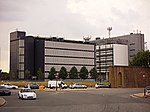Blackwall railway station

Blackwall was a railway station in Blackwall, London, that served as the eastern terminus of the Commercial Railway (later the London and Blackwall Railway). It was located on the south side of the East India Docks, near the shore of the River Thames, 3 miles 43 chains (5.7 km) down-line from the western terminus at Fenchurch Street. The station was designed by architect William Tite in an ornate Italianate style. It opened on 6 July 1840 with services connecting with a ferry service to Gravesend, Kent. Between 1870 and 1890 the station was also served by some North London Railway trains from Broad Street via Hackney and Bow services to connect to the ferry services. The station was renovated at this time.In March 1926 the London and North Eastern Railway and Port of London Authority announced passenger services would be withdrawn on 30 June 1926. However, with the start of the national general strike services were suspended early on 3 May 1926, and never resumed.John Betjeman (1906-1984) in his book First and Last Loves, wrote of a journey on the L&BR "Those frequent and quite empty trains of the Blackwall Railway ran from a special platform at Fenchurch Street. I remember them. Like stagecoaches they rumbled past East End chimney pots, wharves and shipping stopping at empty black stations till they came to a final halt at Blackwall station...When one emerged there, there was nothing to see beyond it but a cobbled quay and a vast stretch of wind whipped water..."The station was demolished in 1946 to make way for Blackwall power station, although the branch continued to carry goods traffic until the demise of the docks in the late 1960s.Today no trace of the two-storey station remains, and the docks have been filled in (although a small basin remains). Its approximate location is now occupied by houses on Jamestown Way. The station site is some distance from the present-day Blackwall DLR station; the closest existing station is actually East India DLR station, which is slightly to the north-west of the original Blackwall station site.
Excerpt from the Wikipedia article Blackwall railway station (License: CC BY-SA 3.0, Authors, Images).Blackwall railway station
Jamestown Way, London Blackwall
Geographical coordinates (GPS) Address Nearby Places Show on map
Geographical coordinates (GPS)
| Latitude | Longitude |
|---|---|
| N 51.50817 ° | E 0.00007 ° |
Address
Jamestown Way
Jamestown Way
E14 2DD London, Blackwall
England, United Kingdom
Open on Google Maps










